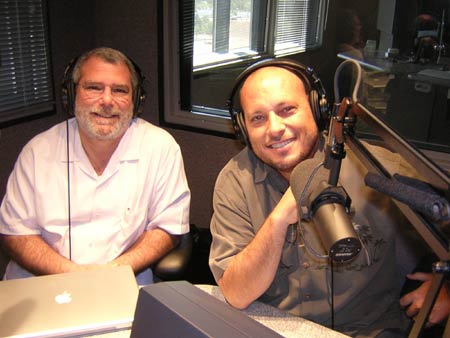News Innovators on the Frontline: The Arizona Guardian
Posted on 28. Jul, 2009 by Damian Ghigliotty in New News Organization, News Ecosystem, Paid Content, Revenue
Often, the slimmer the news organization the more dedicated its staff.
The Arizona Guardian, a subscription-based news site in Phoenix, covers state politics as closely as any of its competitors. Except the Guardian’s five partners manage everything from the site’s political coverage to its information technology and sales. Their initial funder and co-owner, Bob Grossfeld — a political and media strategist — handles the Guardian’s marketing and web development. The other four co-owners, Patti Epler, Mary K. Reinhart, Paul Giblin and Dennis Welch — all veteran journalists — handle the editorial content with the help of one additional part-time reporter and occasional guest columnists. 
The Guardian went live in January 2009 in the wake of an East Valley Tribune layoff storm. As of now the site pulls in about 8,000 unique visitors a month and enough paid subscribers to keep it in the black. The vast majority of those subscribers are members of the Arizona State Legislature and lobbyists, which the Guardian covers “from the inside out.” With hopes of expanding its audience, the site offers three subscription plans: a 6-month “Professional subscription” for $900, a 6-month “Non-Profit subscription” for $720, and a 6-month “Individual subscription” for $180.
We spoke with Patti and Bob earlier this week about their new news organization, which recently won an award for its state government coverage.
How did The Arizona Guardian get started?
Patti: After several of us were laid off from the East Valley Tribune, we got together and talked about starting a political news site. Hooking up with Bob is what really made it happen. What was stumping the band for us as journalists was “how do you do a website?” Bob was far more web-savvy than us and he also had the business side down. So, we came up with the idea of setting up a site that could compete with the Arizona Capitol Times’ Yellow Sheet Report, a subscription-only newsletter that covers politics and political gossip.
Bob: It’s an old-school cooperative. Everybody has something to contribute and it’s not all identical. But that doesn’t mean it’s not all equal. Aside from their time and energy, their investment was effectively their severance pay. We measured the equity by a term you often hear in the construction industry called sweat equity. Everybody had and has a contribution to make and how that contribution translates in terms of currency is somewhat secondary.
What were your upfront costs?
Patti: We basically started with no capitalization, as they like to say in this world. Bob threw $10,000 into a bank account that paid for the legal fees to set up the corporation, since we’re an LLC, as well as some business cards and other minor office expenses. He’s easily recouped that money by now. But there was certainly no major funding behind us.
When we first launched in January, we started working out of the Senate pressroom, which is where all of the other state Capitol reporters were. The Senate had been leasing space to those media outlets for the past 30-40 years. However, the Senate President had already decided to kick the press corps out of the pressroom, because he said he wanted the space for legislative meetings. But who knows? We still think it’s because we were aggressively covering his affairs.

Arizona Guardian co-owner and managing editor Patti Epler
So, we took our little laptops, our Internet cards and our cell phones, and worked out of the Senate hallway for the next couple of weeks. It was actually kind of fun and we got a lot of attention. Lobbyists and legislators would stop by and commiserate.
After that we finally rented some space in the League of Arizona Cities and Towns Building, which is still on the Capitol campus. And now that the rest of the press corps has been kicked out, they’re all moving into the League of Cities building with us.
Now that you guys are situated, are you making a profit?
Bob: Yup. At this point we’re making enough to get everybody paid and keep the place operating. Which is certainly a bit more than what some early predictions were, and a lot more than what some other operations around the country are making solely on advertising. We rely on advertising a bit, but most of our revenue comes from our subscriptions.
Right now about 75% of our readers are involved in state politics and about 25% are civilians, for lack of a better term. But that latter number has grown in the last quarter and eventually we expect that 75/25 will flip. All these news web aggregators can stretch themselves thin recycling other people’s work. But at the end of the day somebody has to do the real reporting, and that’s our niche.
Our model is based on the idea that you’ve got to eat, and effectively you eat what you kill. You want to eat this week? Great, you have to get more subscribers.
Are there ever any conflicts with Bob’s involvement in the political arena?
Patti: Yes. From the beginning when we decided we’d throw in with him, we made it clear that he would have no involvement in the editorial side, whatsoever. He likes to say, “I’m the only publisher in America who can be fired by his reporters.” And to a large degree that’s true, because we could vote him off the island if we ever needed to.
We also made a big point of disclosure. Of just openly saying, “here’s who are, here’s Bob. Bob’s well known in Arizona as a political strategist and in particular as a Democratic political strategist.” So, when we write a story about something that he has had some involvement in we put a note right in the story at that point that explains his background.
Now the people who initially looked at us as a front for the Democrats when we started, no longer think that all. We’ve done a good job of alleviating that.
Have you ever considered expanding to add a full-time sales person?
Patti: One of our goals is to build our business to a point where we can hire more people to take up some of the burden. What we need right now is someone who is a dedicated sales and marketing person. We’ve never had what I would consider a serious advertising or marketing campaign. But we’re doing well for never having really reached out to advertisers.
Bob: We signed up for a few ad networks, but the level of revenue we’ve made is minuscule compared to our subscriptions. Advertising works very well if your goal is to follow the same model that made the old newspapers fail, which is just get as many eyeballs as you possibly can. When you’re doing narrow casting to a niche audience, you can’t build your revenue model based on the quantity of eyeballs, because you’re never going to get there without sacrificing the very product you’re creating.
We could have done more things with advertisers, and probably could still. And at that point we wouldn’t be what we are. We wouldn’t be producing the product that the five of us saw the need for.

Bob Grossfeld and Republican political consultant Stan Barnes on KJZZ's Here and Now. (Photo by Paul Atkinson)


